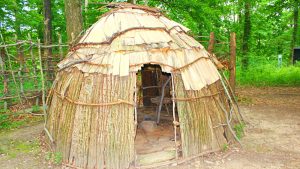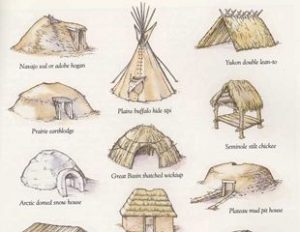Throughout the years, colonists, traders, travelers, artists, early archaeologists, historians, and pioneers have used different English names for the houses or homes where Native American Indians lived. Sometimes, the term “wigwam” was used to label all Native American houses regardless of the location, structure or tribal group. Some writers described the structures as simply “tents” or “houses”. Misnomers and misrepresentations still continue today which makes it hard to study the Native American houses.

The design and style of Native American houses were determined by factors such as the environment, climate and “biomes” or the natural resources available to them. The Native American’s way of life went from nomadic and semi-nomadic to static. Their houses were reflected in their lifestyle. A big part of the United States has many types of climate and land, Native American houses and shelters were determined by the raw materials available in the areas they settled.
The changing season and the weather affected their way of living. Native American houses comprised of a huge variety of styles and designs. The Native American tribes who occupied the borders and edges of the States often reflected several types of houses which suited their way of living depending on season and area.
Lists of Native American Houses

- Tepees – one of the most popular Native American houses. A tent covered with buffalo hide built by the native tribes of the Great Plains
- Wigwams (Birchbark houses) – Cone shaped houses built by Northeast and Eastern Woodlands tribes
- Chickees (Stilt Houses/Platform Houses) built by the Seminole Tribes in Florida
- Wickiups are dome-shaped brush houses built by the Great Basins such as the Goshute, Paiute, and Washoe
- Tule Mat Lodges – Tepee or dome-shaped houses of the Plateau tribes which used woven tule mats for coverings.
- Earth Lodges – Constructed on the grass-covered lowlands of the western plains by the Mandan and Pawnee tribes.
- Hogans – built by the Navajo Native American tribe
- Longhouses – longhouses covered with barks built by tribes like the Iroquois Confederacy of Northeast Woodland
- Cedar Bark Tepees – houses built by California tribes like the Miwok, Maidu, and the Southern Yana
- Grass Houses – Built by the Wintun and Chumash tribes of California.
- Kiich House – built by the Yuma and Serrano tribal group of California.
- Adobe House or Pueblos – Houses built by Southwest tribes such as the Hopi, Pueblo, and Zuni, made of mud bricks.
- Wattle or Daub houses – Built by the Southeast tribes such as the Creeks and Cherokees.
- Plank house – Built by the Chinook, Clatsop, and Tlingit of the Pacific Northwest coast and Sub-Arctic tribes.
- Lean-to: Temporary houses used by various tribes.
- Brush Shelters is a type of make-shift houses used for sleeping and defense against bad elements
- Pit Houses – built by the Indian tribes of the Plateau Group and by some Californian tribes
- Redwood Plank house – built by California tribes like the Mojave and Yurok
- Igloos – The popular snow houses made by the Arctic tribes
- Barbaras – a semi-underground house designed built by the Aleuts.
- Beehive Grass Thatched Houses – Made by the Caddo, Yucci, and Witchita tribes of the Southeastern.
- Sod Houses – Acquired from stone houses by American settlers.
native American houses school project, native American wigwam, native American homes project, native American longhouse, southwest native American homes, Native American teepees, what are wigwams made of, wigwam facts